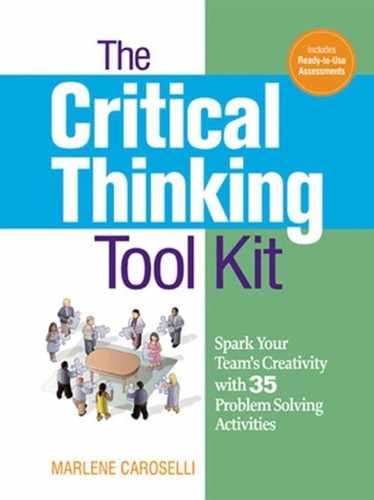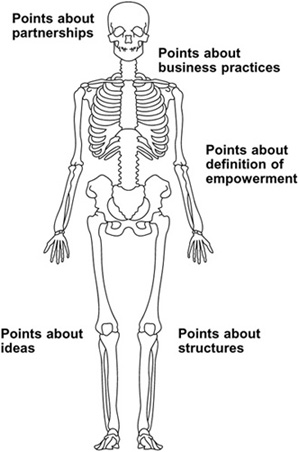#1: Attending to Attention
Overview: |
This activity provides participants with a means of efficiently encoding information by using a framework with which to organize important information in a meaningful way. |
Objective: |
To provide an opportunity for participants to process information more efficiently. |
Supplies: |
Copies of Handout #1-1 |
Time: |
15–20 minutes |
Advance |
Make enough copies of Handout #1-1 for the entire group. Arrange the seating so it is easy for groups of three or four to share their responses. |
Participants/ |
This activity works with any number of participants and is especially useful when one must take notes on significant material presented by a facilitator in a lecture format. It can be used each time a lecture (or mini-lecture) is presented. |
Introduction to Concept:
“Tomorrow’s illiterate,” Herbert Gerjuoy asserts, “will not be the man who cannot read; he will be the man who has not learned how to learn.” An important part of the learning process is paying attention to material we are putting into our storage banks. If we are not concentrating, if we are bored, or if we are anxious or distracted, tired or ill, depressed or excited, we may not be giving the knowledge the attention it deserves. Later, when we go to retrieve it, we will probably have difficulty finding it. When there are gaps in our knowledge, there will be corresponding gaps in our ability to critically assess situations.
When we are missing information we need, we tend to blame a “poor memory.” The real culprit is an inefficient coding system. Inefficiency in this system obviates efficiency in critical thinking, for we cannot give issues a 360-degree scrutiny if we only have a 180-degree perspective.
One of the best examples of an efficient coding system is found in what is called the “skeleton image.”
1. Introduce the Knowledge Skeleton via this presentation:
As you prepare to listen to a lecture on “empowerment,” imagine that the head and each of the limbs of a skeleton represent five large areas within this broad topic. While you listen to my lecture, make notes in one of these five areas and do not—I repeat—do not try to copy every word I say. Instead, record main points as concisely as you can.
Look at these knowledge skeletons now. [Distribute copies of Handout #1-1, one per participant.] Note that the areas for this topic are Business Practices, Definition of empowerment, Structures, Ideas, and Partnerships. With other topics, other areas would be significant. The next time you are in a class, ask your instructor for such an overview so you can easily add “flesh” (your notes, your thoughts) to the bare-bones outline you have been presented with.
2. Distribute Handout #1-1 showing the knowledge skeleton and ask participants to add “flesh” to the bones by writing down important points from the lecture.
3. Read the following aloud:
The Quality movement has forced organizations to examine current business practices, to make changes in work processes, and to create new alliances with customers, employees, and other organizations. This movement has made leadership a practice in which anyone, at any level of the organization, can engage. In the words of author Masaaki Imai of Toyota, the new leadership is based on personal experience and conviction and “not necessarily on authority, rank, or age.”
As we think about the definition of empowerment, we cannot ignore the experience and commitment of employees. When the organization acknowledges these traits and when the organization willingly uses the talents employees are eager to share, then we have a culture of empowerment.
Structures (formal and informal) must be in place, however, so employees’ voices can be heard. In smaller companies, the top executives invite groups of employees to have lunch with them each week so they can get closer to workers and their concerns. Senior managers in empowered organizations earnestly seek information about problems employees may be experiencing and ideas they may have for improvement.
Other companies seek to “hear” employee voices by using suggestion systems. Organizations that have established formal Quality Councils already have in place the structures necessary for translating a team’s well-researched proposal into feasible plans. To be sure, there will be barriers standing in the way of moving ideas from teams to managers to reality. But once these barriers have been identified, team members can work to remove them.
It is imperative that managers actively solicit ideas from subordinates through formal suggestion processes or in less formal ways. Management cannot ignore the potential wealth of ideas waiting to be shared at every level of the organization. As Imai notes in his book Kaizen, in one year alone, 1.5 million suggestions were offered, 95% of which were implemented fully or in part by Toyota management.
When employees feel empowered, they get excited about the possibility of forming new partnerships. These alliances may be made with other organizations through benchmarking. They can also be made with other employees through process improvement teams, with customers through focus groups, with the community at large through new outreach programs. The form of the partnership follows the function of continuous improvement, no matter the forum.
4. Have participants compare the notes they made and discuss the content of the lecture.
5. After five minutes, ask them to put their notes away as you give a quiz:
a. What do you remember about business practices?
b. What do you remember about the definition of empowerment?
c. What do you remember about structures?
d. What do you remember about ideas?
e. What do you remember about partnerships?
6. Ask them to discuss the advantages of taking notes in skeletal fashion as opposed to taking no notes or taking notes in a more haphazard way. For most people, the flesh-to-bones process works quite well. Have participants evaluate it in terms of their recall.
Extending the Activity:
1. Draw the skeleton on a flip chart and label each of the limbs and the head with one of the objectives of the course. (Or use the basic knowledge categories into which you have divided the course.) At the end of the session, have participants write what they remember having learned in each of the categories listed.
2. Preview a video you intend to show in a future class and draw the skeletal divisions on a transparency. Have participants add the flesh of ideas and new knowledge after they have viewed the film.
Workplace Connections:
1. Suggest that employees use the Knowledge Skeleton in this way when they return to work: At their next (and subsequent) staff meeting, a volunteer will keep notes of the meeting’s progress by correlating the skeletal frame to the agenda for the meeting. Minutes could later be distributed—not in their usual typed format, but rather with “bulleted” entries beneath each of the focal points of the meeting.
2. Encourage the use of this framework for individual reading. Before participants begin reading a book or long magazine article, they should skim the Table of Contents or major headings to get an overarching sense of the key points being made. Then, as they are reading, they can add verbal flesh to the skeletal outlines they have prepared.
3. Reinforce the concept and process of efficient encoding by asking participants to think about the one person in their work environment whom they most admire for his or her ability to absorb and retain voluminous amounts of information. Point out that they could learn quite a bit from that individual about the mechanism this person uses to remember important information. Suggest that they invite the person to have coffee or lunch one day and initiate a conversation about this post-session assignment they have been given.
Questions for Further Consideration:
1. You have spent many years acquiring and reusing information. What mechanisms have you developed to efficiently organize and retain information?
2. It is said that the amount of “information pressure” we now experience is at least 30 times as great as it was in the 1980s. What will you do to keep up?
3. In what other areas of your life have you learned to streamline information—processes, paperwork, filing, etc.?
4. Has technology helped you efficiently store and quickly retrieve information, or has it made the process even more complicated? Explain your answer.

